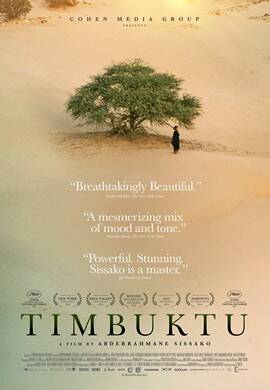Timbuktu is so remote it’s become famous because of it. Its back-of-beyond reputation holds an exotic appeal, which is one reason I wanted to see the film “Timbuktu.” I’d heard good things about it, and I thought the chance to see shots of the ancient city in Mali was itself worth the price of the ticket. Indeed, the beautiful cinematography in this quiet and powerful film is stunning. The light, the river, the desert, the city’s earthen mosques and houses shimmer in a golden haze that seems real and Platonic too. Watching “Timbuktu,” you sometimes feel you’re not only seeing a strange and far-away landscape, but that you’re new born into a world composed of dazzling sun, sand, starlight.
Only later, after I went online to learn more about the director, Abderrahmane Sissako, did I discover that the film was shot on location in Qualata, an oasis town in Mauritania, 40 kilometers from Timbuktu, a caravan city in the 13th and 14th century and the southern transit point of the trans-Saharan trade route. Later, Timbuktu replaced Qualata as the transit point. Both cities are on UNESCO’s list of World Heritage sites.
The merits of the movie do not begin and end with its beauty. “Timbuktu” is compelling. If a picture is a worth a thousand words, then a moving picture is that many times over. Americans puzzling over what is happening in parts of Africa and the Near East with ISIL, Boko Haram and other militant Islamist groups vying for power will learn more about what that involves from seeing “Timbuktu” than from reading any number of articles. While a feature film, not a documentary, the movie shadows real life and shows the effect of jihadis taking over the city, as they in fact did in 2012 before being ousted by French and Malian troops a year later. The intruders impose their strict interpretation of Islamic law on the city, forbidding cigarettes, drinking, singing, playing music and football. The movie shows the tensions between the city’s residents and the newcomers who now have authority over them.
If you’ve ever wondered what it would be like for fundamentalists to move in next door and take over City Hall, this movie answers that question within the context of recent events in Mali. It does this while showing you enough about the jihadis to make you see them as individuals, human beings prey to hypocrisy, ignorance, self-deception and longing. These are the new Puritans of our age, full of zeal and a passion for literalism. Watching them vandalize old works of art, you’re reminded of the Protestant reformers who took an axe to the statues in Catholic churches to destroy idolatry.
Not all of the militants in the movie are young, but for the most part they seem young. Their self-confidence is enormous. Some of the film’s most interesting moments are when their certainty is breached by encounters with others secure in their convictions and character – an imam in the mosque who lectures the militants on what jihad really means and shows them the shallowness of their religious understanding; a mother who refuses a jihadi who asks for her daughter’s hand in marriage despite the implicit and then explicit threat he holds; a fishmonger exasperated at the demand that she wear gloves when handling fish and unafraid to show what she thinks of the bumptious upstarts who are turning life upside down. It’s these moments when you see the local culture reacting to the fundamentalist demands of the interlopers that you feel brought into the drama that is happening in different parts of the Middle East and Africa.
The movie’s main plot focuses on one family: Kidane, a herdsman; his wife, Satima; and his 12-year-old daughter Toya. They live outside town in a tent on the sand dunes, trying to avoid the trouble within the city. The pace of life is slow; one disturbing element in it is a jihadi who casts a covetous eye on Satima and stops by to see her when her husband isn’t around. Coming one day while she is washing her hair, he reproaches her for not covering her head; she tells him if it offends him he shouldn’t look. The tension is palpable, but what breaks the halcyon tenor of the family’s life is more mundane. Kidane’s young shepherd, Issa, lets a prize cow wander into the river and it fractures the nets of a fisherman. This triggers a chain of events that leads to Kidane being hauled before the authorities.
Viewers should see for themselves what ensues, but in a movie full of striking images the last one of Toya running across the sands possesses the poignancy and metaphoric power the director intends. Other images, one giving flesh to Jesus’ injunction that he who is without sin should cast the first stone, will linger in my mind for a long time. The damage wrought by those fervently seeking salvation is the subject of this artful film that puts contemporary events in a thoughtful context.








